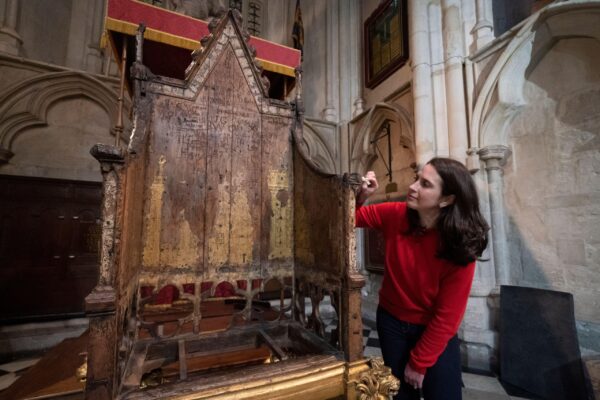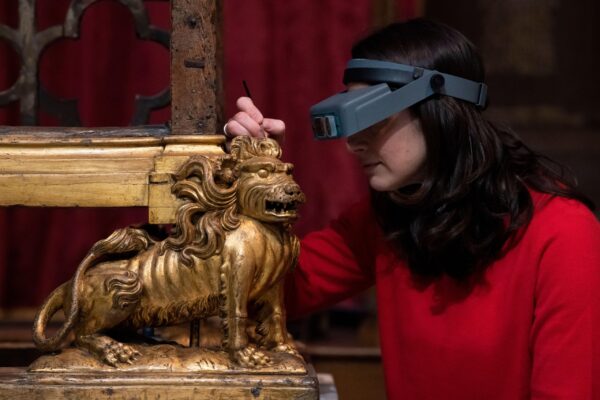
News Archive 2023
An interview with Krista Blessley, Courtauld alumna and Paintings Conservator at Westminster Abbey
On the occasion of the Coronation of King Charles III on 6 May 2023, the Coronation Chair, one of the most precious and famous pieces of furniture in the world, has undergone conservation work to restore its former glory through cleaning, and stabilisation of the precious gilding.
We sat down with Courtauld alumna Krista Blessley (MA Conservation of Easel Paintings, 2009), Paintings Conservator at Westminster Abbey, on her time at The Courtauld and how it got her where she is today.
Can you tell us a bit about what you did before coming to The Courtauld and what made you decide to consider conservation as field of study?
I studied History of Art with Material Studies at UCL where I learnt about artists’ materials and techniques, how paintings change over time and it is here that I was introduced to conservation. The combination of science, history of art and the practical skills involved in conservation were appealing as was the prospect of being able to care for works of art that form part of our cultural heritage.
Why did you choose to study at The Courtauld?
The Easel Paintings Conservation programme is world-renowned and highly respected. For me, it was the clear and only choice.
Did you receive any scholarship or bursary funding? If yes or no, why are scholarships/bursaries important to students studying conservation in particular?
I did not receive any scholarship or bursary funding. I was very fortunate to be financially supported by my parents. It is a full-time course that requires a huge amount of commitment and time so undertaking part-time work around the demands of the course is extremely difficult. Funding and bursaries are esential to enable students of all backgrounds to be able to do this wonderful degree.
Can you tell us a bit about your experiences at The Courtauld?
I studied at The Courtauld from 2006 – 2009. I learnt an incredible amount from my teachers, found lifelong friends with my classmates and made professional connections that proved invaluable throughout my career. Study trips to Munich, Stuttgart, Florence and Rome also opened my eyes to varying international approaches to conservation. Through the programme I obtained work experience and summer work at London galleries and museums as well as Westminster Abbey.
How are you using the skills acquired at The Courtauld to support your work today?
Although my degree from the Courtauld is in the conservation of easel paintings, throughout my career at the Abbey I have applied the knowledge and experience I gained there to the conservation of paintings, sculpture, polychrome tombs and most recently to the Coronation Chair.
Can you share with us some of the highlights of where you have worked and what you have conserved since graduating?
I have been very lucky to have worked internationally for museums and private clients in Europe, the United States and the Middle East. Some of the highlights have included the Impressionist paintings at the Fitzwilliam Museum and all of the paintings at Kenwood House. At the Abbey, the polychrome royal funeral effigies and the Coronation Chair have been particularly special.
Being a conservator is an incredible job. I feel lucky to have found this career and the CIA programme provided me with the first important step into it.

